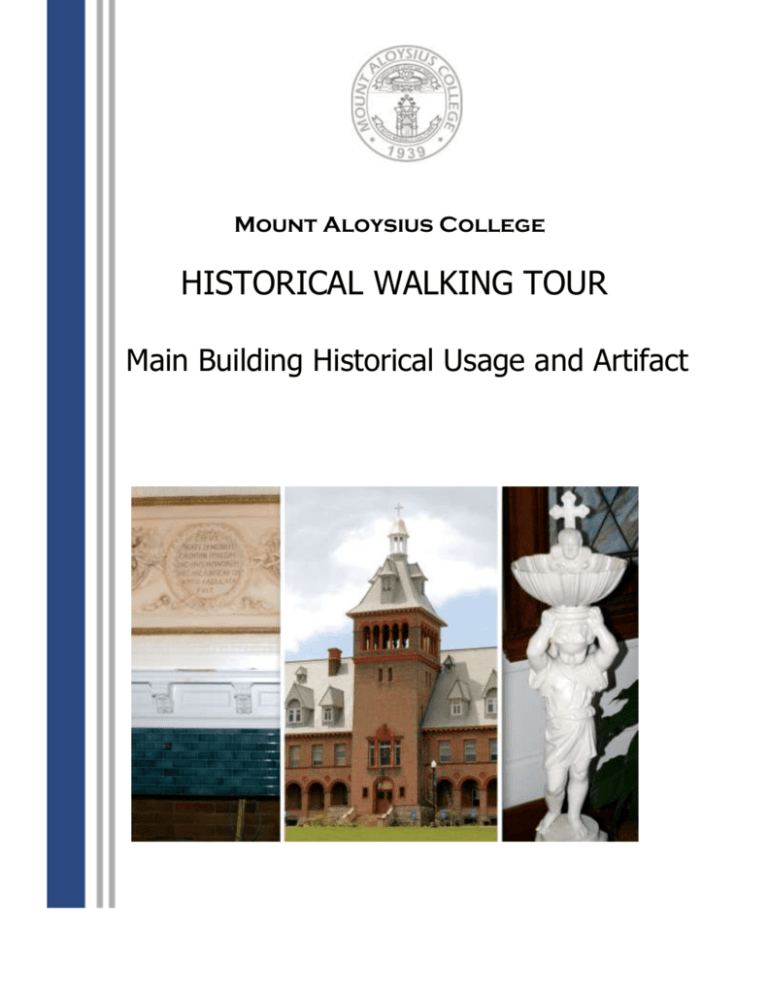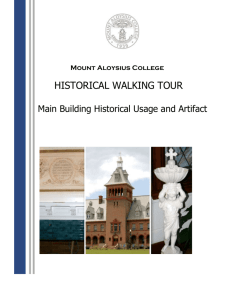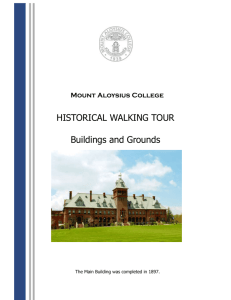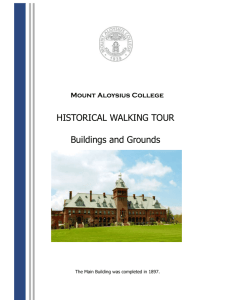Main Building - Mount Aloysius College
advertisement

Mount Aloysius College HISTORICAL WALKING TOUR Main Building Historical Usage and Artifact Background Information Demetrius A. Gallitzin, Apostle of the Alleghenies, founded the first Catholic parish in the Allegheny Mountains, naming the settlement “Loretto”. Eight years after his death in 1840, the Sisters of Mercy took up residence in Loretto and opened a small school in a tinsmith’s shop. Demetrius Gallitzin Sister Gertrude Blake obtained land in Loretto to build a convent and an academy for young girls. On May 14, 1853, the structure became the Academy of Our Lady of Loretto, later named Saint Aloysius Academy, in honor of Saint Aloysius Gonzaga, the patron of youth. The Shrine of Our Lady of the Alleghenies, designed by Sister Mary Benedicta San Antonio, RSM, currently occupies the site of the academy there. Under the leadership of Mother Mary de Sales Ihmsen and Mother Mary Gertrude Cosgrave, the school and religious community prospered. A parcel of land was purchased in Cresson from the Frank Powers family. In 1897, the motherhouse and academy moved to Cresson, an area more accessible to students because of its proximity to the mainline of the Pennsylvania Railroad. The academy was renamed Mount Aloysius Academy. The Main Building, constructed in the 1890s, was fashioned after a French chateau and was designed by renowned Pittsburgh architects Longfellow, Alden and Harlow. The interior boasts woodwork hewn from the property’s cherry, maple and oak trees. Entrance, to far right As you enter through the large wooden side door, an early hall rack and mirror stand immediately to your left. Note the ornate leather backing and the umbrella stand on the right side. Proceed through the inner door and you will find, on the left wall, pictures of two women significant in the history of Mount Aloysius College. The two large paintings hanging on the left wall portray Amelia Ihmsen and Emma Cosgrave, who later became Sister Mary de Sales Ihmsen and Sister Mary Gertrude Cosgrave. The bronze tablet is dedicated to Mother de Sales, foundress of the Sisters of Mercy, Loretto-Cresson Community. Room 113 – Enrollment Processing Center This area is currently used by the Enrollment Processing Center. Most recently it was the Office for Graduate Studies and Continuing Education; from the 1890’s to the 1990’s, it was the Registrar’s Office for the academy and the college. Note the brass plate on the door – all that remains of the “Registrar’s Office.” Note the fireplace to the right as you enter the door. There are more than thirty-three fireplaces in the Main Building, and no two are alike. This one is a sandstone and brick design. The fireplaces were the only source of heat in the entire building in the early years, but today they are all decorative. The print above the fireplace, entitled “Angels of the Passion,” is a copy. The original hangs in the Metropolitan Museum of Art in New York City. Note that each angel holds an instrument of the Passion of Jesus Christ. Room 115 – Office of Administrative Assistant to the President This area was formerly one of several parlors for visitors to Mount Aloysius Academy and, then, the Junior College. Originally this parlor was called the Maple Parlor because of the Bird’s Eye Maple on the back of the office door and the wainscoting all around this room. Note the fireplace here which is made of emerald green tile. In an earlier time, a Mrs. Pollard furnished this room with light green furniture to match the green tiled fireplace. Note also the mirror above the fireplace – a feature found in several rooms of this building. The chrysanthemum painting to the right as you enter the office is the work of Sister Josephine Ihmsen, artist and cousin of the foundress. The painting of the Madonna to the left of the fireplace is also one of Sister Josephine’s works. At one time, several of her paintings hung in various places throughout the Main Building. Room 117 - President’s Office This area was also formerly a visitor’s parlor for Academy and Junior College guests. It was called the Aloysian Parlor, after the patron saint of the Academy, St. Aloysius Gonzaga. Note the oval painting above the fireplace. This room was just about ready to be used when the large oval mirror set above this fireplace was broken – leaving a gaping hole that had to be fixed. Sr. Mary Josephine Ihmsen, whose painting is in the outer room, asked for a stepladder and sandpaper. She smoothed out the boards that lay behind the broken mirror and began to paint. The panel of chrysanthemums resulted and was never replaced. Main Entryway The central hall and main entrance of this main building is directly under the bell tower. The wood paneling is golden oak, carved in Boston. The wainscoting up the stairs is also golden oak, as are the tall columns supporting this stairway and the columns at the fireplace. Evidently golden was the color scheme for the Sienna marble of the fireplace reflects the color of the wood. The painting to your right as you enter the building depicts Catherine Elizabeth McAuley, the foundress of the Sisters of Mercy. Catherine founded the Sisters of Mercy in 1831 in Dublin, Ireland. She used her inheritance in service to the needs of her time and had a special concern for persons who were poor, sick or ignorant; for the needs of women; and for the faith formation of all persons. Before her death in 1841, Sisters of Mercy were engaged in the spiritual and corporal works of Mercy in settings throughout Ireland and England. A Della Robbia bas relief adorns the mantel of the fireplace in this entryway. The children depicted here are a copy from Della Robbia’s famous singing choir. The original masterpiece of the choir is found in the sculptor’s home town, Florence, Italy. There are several Della Robbia pieces throughout the first floor of the Main Building. Since the time of the Academy the staircase in the main entrance has been called “The Golden Staircase.” Academy students were rarely allowed to use the stairs. The staircase is built into the Bell Tower of the building. Originally a water tank was housed in the upper stories of the tower and provided water to the Main Building. Water was pumped to the tower tank from a cistern on the property and the height of the tower provided sufficient pressure to feed the water throughout the building. The Angel Holy Water Fountain standing under the staircase is one of few artifacts salvaged from the fire which destroyed the Academy and Convent in Loretto in 1904. The fountain stood at the entrance to the Chapel in that older building. Room 119-120 - Office of the Registrar The two rooms currently housing the Registrar’s office were formerly parlors for visitors. These rooms housed several Madonnas, so the parlor currently housing the Registrar’s Office was called the Madonna Parlor. The fireplace in the Registrar’s Office is made of rich blue tile. The graceful angels surrounding a medallion on which a Latin inscription is chiseled are a unique feature of this fireplace. This is a copy of a memorial tablet of a Bishop Zenobius. This piece and many other artistic selections throughout the Main Building attest to the emphasis placed on a liberal arts, classical education in the design of the building. The outer room of this office space was sometimes called the Sisters’ Parlor. Since at one time there was no parlor in the convent, this parlor was reserved mainly for Sisters and their guests. In the early years of the Academy, the deceased Sisters of Mercy often were waked in this parlor. In this outer office the fireplace is made of lighter tile and features glass display cabinets on top of the mantel. The room was originally intended to be a museum, but the intent was never brought to reality. Room 122 & 124 - Financial Aid and Finance Offices At the time of the Academy and Junior College, these rooms housed the Academy dining room and the Sisters’ living or community room. An artifact from those days, but not available for viewing, is a dumbwaiter which is currently a part of the storage area of the Financial Aid Office. Since the room next to the Sisters’ living room was a dining room for visitors, the dumbwaiter served to transport food for both the community and visitor’s dining room. Room 120 - Memorabilia Room This area was formerly the guest/priest dining room. The Memorabilia Room was established in 1981 through the efforts of Sister Mary Claver Cronin. She wanted to display some of the institution’s heritage and some of its priceless objects. The room has a fireplace in the center of whose mantel sits a Della Robbia Madonna. On the mantel and on the floor near the fireplace are several vases brought by Academy students from various countries and donated to the school. The Frederick Whittaker watercolors in this room were given to Mother Xavier Phelan in the 1930s. Note also the banner depicting the college seal with its motto: “With our light we serve”. The cherry wood for this room was cut from trees on the property. Some of the chairs and the settee are of rosewood; the light oak table comes from the 1890s. Room 105 - Wolf Kuhn Gallery This area has served three major functions within the institution: originally, a chapel, later, a library for the Academy and Junior College, and now an art gallery and meeting room. Many of the stained glass windows throughout the Main Building adorned this room when it was a chapel (1897-1924). Note also the raised platform area to the right of the entrance. This served as the sanctuary area for the chapel. The several permanent paintings in the Gallery date back to the 1890s and 1920s. In the former sanctuary area, moving from right to left, you will find several Martin B. Leisser paintings. These paintings came into the possession of the Sisters of the Sisters of Mercy through Sister Mary Josephine Ihmsen (18621950). Hildegarde (her baptismal name) was the daughter of Frederick L. Ihmsen who was the son of Christian Ihmsen, one of the pioneer glass manufacturers of Pittsburgh, Pa. She was also the niece of Mother Mary deSales Ihmsen, foundress of the Cresson Community and Mount Aloysius Academy (now Mount Aloysius College). Hildegarde was an exceptionally intelligent and attractive girl who, having a wealthy father, had the advantage of attending schools in Europe, where she acquired the ability to speak both German and French fluently. She entered the Religious Sisters of Mercy in Loretto and later taught at Mount Aloysius Academy in Cresson. She had a genius and reputation for teaching language, art, music, and elocution. Sister Mary Josephine not only directed many plays at the Academy, but also painted the scenery and made the costumes. She was truly a gifted artist. A few of her paintings still hang at Mount Aloysius. Probably it was during her studies abroad that she became acquainted with Martin B. Leisser, who was also from Pittsburgh. She would have been 25 years old in 1887, the date that was marked in the collection of Leisser paintings at Mount Aloysius which include: Head of Woman Head of Black Male Head of Man w/Earring (shown above, right) Man Without Shirt Head of Young Man Man with Head Bowed (shown above, left) Elderly Gentleman with Golden Cloak In addition to the Leisser paintings, there is a wonderful picture entitled “Ruth”. This painting was the gift of Mr. and Mrs. Charles Schwab on the occasion of Mother Gertrude Cosgrave’s Golden (50th) Jubilee as a Sister of Mercy. Both this work and the “Mary Magdalene” painting hanging nearby are ornately framed as well as beautifully executed works of art. The left side of the sanctuary area is a circular room of the Norman Tower, which extends upward through all four floors of the Main Building. Second Floor - Our Lady of Mercy Chapel Our Lady of Mercy Chapel is European in style and monastic in arrangements. Originally the ornate rood screen separated the religious community from students and guests. Note the two carved angel figures standing guard on the columns of the rood screen. Note also the carefully carved designs on the screen and the two rows of dark oak stalls lining the front walls as well as the chapel-side of the rood screen. The wood furnishing also contains many examples of the egg and dart design famous in wood carvings. Until the mid-twentieth century, the Sisters of Mercy daily offered the Hours of the Blessed Virgin Mary in this chapel, recited or sung in two choirs facing one another. The altar is Sienna marble and Mexican onyx. The four corner tiles in the floor around the main altar show the symbols of the four Evangelists: Matthew, Mark, Luke and John. The stained glass windows throughout the chapel, the focus of another tour booklet, are fashioned from blown and rolled glass from England, France, Germany, Belgium and the United States. These windows depict Scriptural stories of the Jewish people as well as early Christian saints. The baldachino above the main altar was added in 1932, about ten years after the chapel was built. Note the intricate and delicate carvings of this canopy, especially the manner in which the angels appear to be in flight in the thrust of their bodies and the strength of their wings. This wonderful artifact was generously donated by a parish in Pittsburgh when they discovered they were unable to use the canopy in their parish church. A statue located in the back of the chapel near the confessionals reflects the theology and devotion of early twentieth century Catholicism. The statue “Jesus Scourged” was a gift to Sister Mary Teresita Doyle, R.S.M., from Margaret Warner, a graduate of Mount Aloysius Academy. The Statue was sent to sister in 1938. The manufacturer of the statue was Deprato Studios, no longer operating. Very few of these statues exist at the present time. Another treasure on campus is the Raphael Monstrance. Raphael designed and painted a fresco called “La disputa del sacramento” in the Apostolic Palace in the Vatican in Rome. In the center of the picture, there is a monstrance (an artifact used in Roman Catholic worship services). Gathered around the monstrance are many figures of saints who had great devotion to the Blessed Sacrament. Gold copies of this monstrance were made for St. Peter’s Basilica in Rome, the Vatican, as well as for a college in Rome and two churches, one in New York City. Mother Mary Xavier Phelan and Sister Mary Evangelist Phelan, after seeing the painting in a trip to Europe, determined to collect metal and jewels to create such a monstrance for the chapel at Mount Aloysius. The collection from friends and family took a long time, but finally enough was collected to take to Florence, Italy, where a goldsmith on Ponto Vecchio agreed to do the work. Deep purple amethysts taken from a necklace of Mother Xavier’s mother as well as a diamond crescent from Colette Phelan (Sister to Mother Xavier and Sister Mary Evangelist) adorn this unusual monstrance. Because of the great value of this monstrance, it is kept in a safe and is not available for public viewing. Mount Aloysius College traces its roots to Mount Aloysius Academy, opened in 1853 by Sisters of Mercy who emigrated from Dublin, Ireland. The College encourages students “to synthesize faith with learning, to develop competence with compassion, to put talents and gifts at the service of others and to assume leadership in the world community.” Today at Mount Aloysius, students can choose from over 70 programs of study and develop their skills to a state of the art level. Like President Foley, 70% of Mount Aloysius students represent the first generation in their families to attend college. The beautiful and historic campus is located on 193 acres in central Pennsylvania, at the summit of the Alleghenies in Cresson. Brochure compiled by Helen Marie Burns, RSM, September 2011








